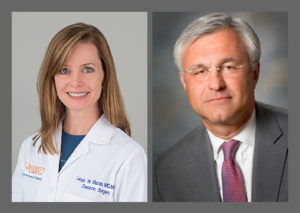- Adult Heart DiseaseDiseases of the arteries, valves, and aorta, as well as cardiac rhythm disturbances
- Pediatric and Congenital Heart DiseaseHeart abnormalities that are present at birth in children, as well as in adults
- Lung, Esophageal, and Other Chest DiseasesDiseases of the lung, esophagus, and chest wall
- ProceduresCommon surgical procedures of the heart, lungs, and esophagus
- Before, During, and After SurgeryHow to prepare for and recover from your surgery
October 29, 2018
Image


What is enhanced recovery?
Surgery is psychologically and physically stressful for patients, especially when it relates to a cancer diagnosis. Lung cancer affects more than 230,000 Americans each year, and when the cancer is operable, surgery is the best chance for a cure. Unfortunately, the incisions required to remove a lung cancer can be very painful. This can make deep breathing, coughing, and getting back on your feet more difficult. Efforts to minimize this stress and pain and return a patient to normal function as soon as possible are the main goals of an enhanced recovery program for lung surgery patients.
The idea of enhanced recovery has been around for 15-20 years. It was pioneered in Europe and first used following an abdominal surgery, such as the removal of colon cancer. Enhanced recovery is based on concepts like:
- Letting patients eat and drink closer to the time of surgery
- Starting to eat as soon as possible after surgery
- Minimizing IV fluids to avoid puffiness and organ swelling
- Maintaining a comfortable body temperature before, during, and after surgery
- Getting patients on their feet and moving around as soon as possible after surgery
- Minimizing the use of tubes and drains and removing them as soon as possible
In addition, enhanced recovery involves finding strategies to prevent and treat pain by using drugs with the fewest side effects. This means avoiding the use of strong, narcotic-type of medications that have unpleasant and potentially dangerous side effects. Some of the side effects are nausea, constipation, feeling “woozy” or sleepy, itching, and loss of appetite. Patients on these medications also are at risk for addiction. This doesn’t happen often, but doctors and nurses pay close attention to help prevent this from happening to their patients.
Patient education and involvement in the process
Enhanced recovery protocols have challenged doctors and nurses to “think outside the box,” which means going back to the drawing board with regard to many aspects of surgical patient care. Much of enhanced recovery centers on patient education about what to expect at each step of the surgical journey—from clinic visits to treatment options, all the way through the hospital stay and follow-up appointments. Setting and meeting goals for recovery are important. The idea is to involve and motivate patients to get through their surgical procedures and recoveries as smoothly as possible. The doctors and nurses make every effort to help the patients get up and out of bed, by removing tubes, lines, and IV fluids, as well as avoiding medicine that may cause sleepiness or nausea.
Why does this matter to patients?
Institutions that develop enhanced recovery programs are more patient-centered. This means they have focused a great deal of attention on how to help their patients have the best possible outcomes following surgery. Continued reviews of how well the program is working help guide regular adjustments and improvements to the program. Many studies have shown that patients in enhanced recovery programs have better results, including faster recovery times, fewer complications, and a lower chance of being admitted back into the hospital after returning home. Some programs also have shown that patients in enhanced recovery programs use less narcotic medication yet have the same amount of or less pain than with traditional approaches.
The last, and perhaps most important reason, to consider having surgery in a hospital that offers enhanced recovery for thoracic surgery is that it might affect results with cancer treatment. In fact, it may even result in a better chance of beating cancer. Patients who recover and feel that they are back to normal more quickly are more likely to get chemotherapy or radiation on time (if prescribed as part of their cancer care). In addition, it is likely that these patients will be able to handle the full dose of treatment recommended. More research focusing on this possible impact and benefit of enhanced recovery programs is under way.
The opinions expressed in this article are those of the author and do not necessarily reflect the views of The Society of Thoracic Surgeons.

